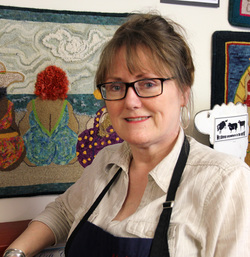
I have learned so much from this group both in hooking and just in a simple sister-hood of sharing. We meet twice a week and once a month for a Saturday hook-In. Laughter is our main production...after that is hooking, eating and learning from each other. What a JOY
About my Green Man
First of all, I fell in love with the pattern the first time I laid eyes on it. I knew at once that I wanted to hook it in blue-greens and I always saw it as a mask. Viewing the pattern on the Encompassing Designs website, I never saw the feathers, wings or the snake so when I received the pattern I was flummoxed. Whatever was I to do? After much soul searching I decided to just hook it as I had imagined it in my mind’s eye (with apologies to the creator and hope that it was a modification that would not offend).
The pattern was a joy to hook. The face opens a world of possibilities...I'm even tempted to try it again in another color way.
After I finished all of the "tendrils", I spread white glue on the back and cut the mask out...no binding or other finishing. I have hung it on the wall just as one might hang a real mask...my Green Man smiles down on me every day and I smile back.
For our ancient ancestors, many spirits and deities were associated with nature, wildlife, and plant growth. After all, if you had just spent the winter starving and freezing, when spring arrived it was certainly time to give thanks to whatever spirits watched over your tribe. The spring season, is typically tied to a number of pre-Christian nature spirits. Many of these are similar in origin and characteristics, but tend to vary based on region and language.
Strongly connected to Jack in the Green and the May King, during the fall harvest, the figure known as the Green Man is a god of vegetation and plant life. He symbolizes the life that is found in the natural plant world, and in the earth itself. Consider, for a moment, the forest. In the British Isles, the forests a thousand years ago were vast, spreading for miles and miles, farther than the eye could see. Because of the sheer size, the forest could be a dark and scary place.
However, it was also a place you had to enter, whether you wanted to or not, because it provided meat for hunting, plants for eating, and wood for burning and building. In the winter, the forest must have seemed quite dead and desolate... but in the spring, it returned to life. It would be logical for early peoples to have applied some sort of spiritual aspect to the cycle of life, death and rebirth.
The Green Man is typically portrayed as a human face surrounded by dense foliage. Such images appear as far back as the eleventh century, in church carvings. As Christianity spread, the Green Man went into hiding, with stonemasons leaving secret images of his face around cathedrals and churches. He enjoyed a revival during the Victorian era, when he became popular with architects, who used his visage as a decorative aspect in buildings.








 RSS Feed
RSS Feed






